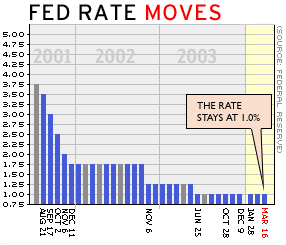NEW YORK (CNN/Money) - Another day, another bond-market bloodbath -- strong economic data hammered the U.S. Treasury market on Friday and Monday, sending interest rates higher, which would seem to endanger the health of a rate-sensitive U.S. economy.
But rates are still low, historically speaking, and economists said Monday they aren't likely to do much damage to an economic recovery that seems to be hitting its stride.
| The effect of rising rates on:
|

|
|
|
|
Friday's bond-crushing report was the Labor Department's bombshell that non-farm payrolls grew by 308,000 new jobs in March. Traders sold bonds early -- maybe too early, according to some -- and often on the news, and the yield on the 10-year Treasury note, which moves opposite to price, jumped to 4.14 percent on the day, compared with Thursday's close of 3.90 percent.
On Monday, the Institute for Supply Management said its index of service-sector health set a new record in March. That's not saying much, since the index is less than seven years old, but it added to the bond-market pain, sending the 10-year yield up to 4.21 percent.

All this comes amid signs that the Bank of Japan has slowed its buying of U.S. Treasurys, at least for the time being, putting further downward pressure on bond prices and upward pressure on yields.
Though higher interest rates are usually a bane to the U.S. economy, most economists were fairly sanguine about the recent gains, especially since we've seen them before, and quite recently, at that.
"[Monday's 10-year yield] is really not out of line with the average rate we've seen in the past six to nine months," said Doug Porter, senior economist with BMO Nesbitt Burns. "The kind of levels where I'd be getting concerned would be from about 4.5 percent and up."
Other economists think bond yields could go even higher than that and still be tolerable -- Robert MacIntosh, bond fund manager and chief economist at Eaton Vance Management in Boston, believes the 10-year yield could go as high as 4.75 percent this year, a level he says would still be conducive to economic growth.
| Related stories
|

|
|
|
|
The risk of a much scarier run-up in rates is tempered, MacIntosh and other economists believe, by lingering slack in the economy that could keep inflation pressures relatively low throughout much of the year, letting the Federal Reserve take its time in raising its target for a key overnight lending rate.
The Fed, the nation's central bank, raises the overnight fed funds rate when it wants to fight off inflation and lowers the rate when it wants to spur growth, and longer-term interest rates typically follow the Fed's lead.
Even if the Fed were to start raising its target for the fed funds rate this summer, as most traders expect, the rate's at a 40-year low right now, and the Fed might be able to move slowly, easing the economy's transition.
And if rates rise because of stronger economic data, then it stands to reason that the economy might be strong enough to withstand some higher rates anyway.
"When rate increases are demand-driven, meaning there are other, positive influences going on -- job growth, demand picking up, etc. -- in that case, the effect of higher interest rates is a small dampening, rather than one that puts the economy at risk," said Michael Moran, chief economist at Daiwa Securities.
Stocks look for a 'goldilocks' economy
Still, sales of rate-sensitive stuff -- including houses and cars -- could suffer a bit, taking some of the sap out of economic growth.
Such a dampening, according to David Sloan, senior economist at 4CAST Ltd., a market and economics research firm in New York, might result in an annualized rate of economic growth in the neighborhood of 3.5 percent to 4 percent -- in other words, far from a recession.
YOUR E-MAIL ALERTS
|
Follow the news that matters to you. Create your own alert to be notified on topics you're interested in.
Or, visit Popular Alerts for suggestions.
|
|
|
 |
But some stock prices could suffer more than that.
"If rates keep going higher, that will pose some problems to sizeable chunks of the stock market, particularly financials and other areas that are interest-rate sensitive," said Carlos Asilis, portfolio manager with the hedge fund Vega Asset Management.
Asilis said the impact will depend on the interplay of jobs and rates -- if jobs move too far too fast, then the Fed may be forced to raise rates sooner, hurting the economy and stocks. If jobs don't keep growing, then consumers may have less money to spend, also hurting the economy and stocks.
A "Goldilocks" economy would be the best thing for everybody concerned, then -- one that's not too hot and not too cold, with job growth of about 125,000 to 150,000 jobs per month and a cool-down of recent gains in commodity prices and other inflation indicators.
"Stocks will probably hit a wall in the next couple of months, unless we move closer to the Goldilocks scenario," Asilis said.

|

